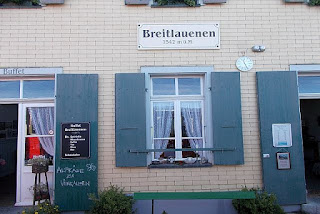 |
| The Schynige Platte chugs its way high into the Alps (MySwitzerland.com) |
BERNESE OBERLAND , SWITZERLAND
— Switzerland
There
is, however, another marvelous train that is frequently overlooked by helter-skelter
wanderers which has been known a local favorite for more than a century.
 |
| Over a century of rail travel (Taylor) |
The
Schynige Platte Railway opened in May 1893 using steam traction before being
electrified in 1914. The rack railway with a gradient of 25% connects the village of Wilderswil ,
near Interlaken
In
addition, there are also impressive views of the Eiger, Monch and Jungfrau as
well as the town of Interlaken
 |
| The Eiger, Monch and Jungfrau are visible from Schynige Platte (wikipedia) |
When the
original Alpenrose Hotel was no longer able to accommodate the influx of Swiss
visitors, the Schynige Platte Mountain Hotel was built and opened in 1894. Just
four years later, in the early morning hours of July 25, 1898, Hotel Schynige
Platte was engulfed in flames and burned to the ground.
 |
| Mountain views at every turn (Taylor) |
Shortly
before the turn of the 20th century, in 1899, the new hotel, which remains
active today, opened to offer guests breathtaking vistas of the Bernese
Oberland's big three: the Eiger, Monch and Jungfrau .
Along with views of the Lutschen Valleys and Lake Thun
Today,
the hotel features alpine antiques that include chests of drawers with marble
tops, rustic beds and duvets, charming porcelain basins and water jugs complete
with furnishings that create old-world ambiance amid mountainous splendor. By
design, telephones and televisions are not part of the accommodation
appointments thanks to management's belief that visitors should have the
opportunity to savor the sensational mountain sunrises and sunsets without the
temptation of modern distractions.
 |
| The mournful sounds of alphorns is a Swiss tradition (Taylor) |
A visit
to Schynige Platte is a summertime outing operating from the beginning of June
to the middle of October. The reason is due to heavy snows and occasional
avalanches which impose their seasonal disruption in the upper section of the
rail route between Breitlauenen and the summit.
In fact,
once the last train of the season has ceased its operation, the overhead
catenary on the upper section of track is dismantled and reconstructed the
following year prior to the first run of the new season. The construction takes
a day to complete, using the lone remaining steam locomotive and six employees
to finish the job.
 |
| Making tracks to the summit of Schynige Platte (wikipedia) |
Four
electric engines, as well as the one original steam locomotive, are used to
push trains up the mountain or to lead it down. During the season trains
operate every 40 minutes with a traveling time of 52 minutes. Upon arrival at
the terminus of one of the highest mountain railways in Switzerland
 |
| The alpine garden is a favorite (Taylor) |
The most
popular attraction, other than the magnificent scenery, is the Schynige Platte
Alpine Garden which specializes in researching the high altitude flora of Switzerland Institute
of Plant Sciences at the University of Bern
Established
in 1928, an area of over 86,000 square feet was fenced off and opened to the
public after centuries of use as alpine pasture.
 |
| Schynige Platte overlooks Interlaken's two lakes, Thun and Brienz (Taylor) |
As might
be expected, hiking, always a favorite pastime in Switzerland
Beginning
at Wilderswil, the train ride itself passes through dense forests that includes
a loop at Rotenegg. Once you "see the forest for its trees" the
woodlands yield to rolling alpine pastures with views of the Bernese Oberland
and Interlaken Lake Brienz and Lake
Thun which frame Interlaken
 |
| Breitlauenen is the only stop
en route (Taylor)
|
is the site of another passing loop as well as the rail line's only
intermediate stop at an altitude of just over 5,000 ft.
Saving
perhaps the best for last, the final ascent reveals the glistening snow-capped
panoramas of the famed Eiger, Monch and Jungfrau Mountains
The
Schynige Platte is well-known to the Swiss, but
frequently overlooked by visitors to the country partly because of other
better known destinations. If time permits, it's an outing that makes for a
marvelous day trip filled with a variety of activities.
 |
| Every place in Switzerland is a photo op (Taylor) |
If time
doesn't permit, it might be a good idea to re-do your itinerary or, at the very
least, make plans to visit during your
next trip to Switzerland








0 comments:
Post a Comment